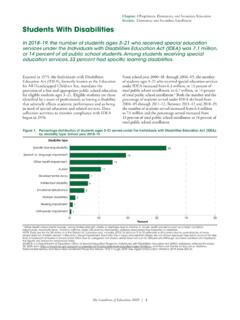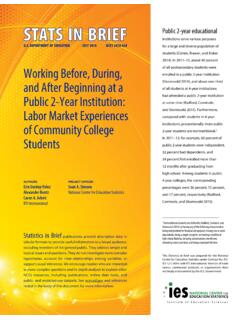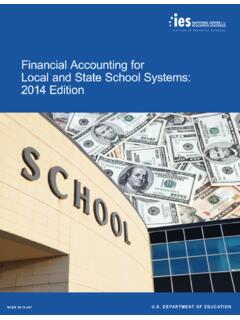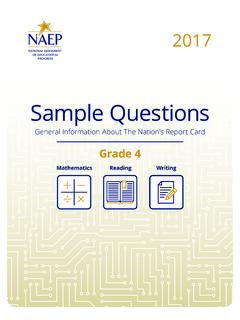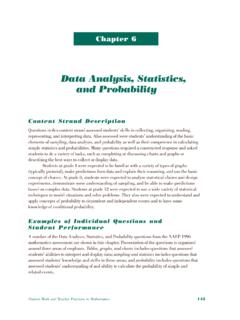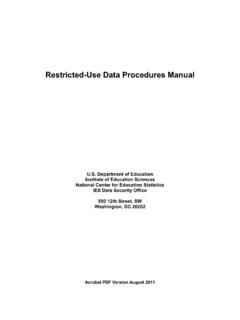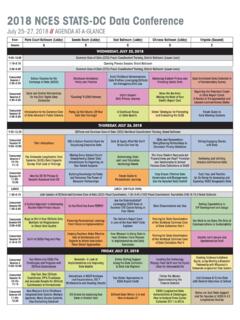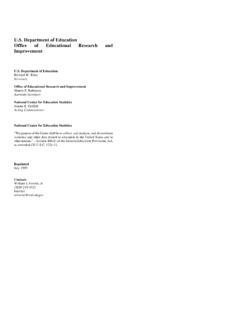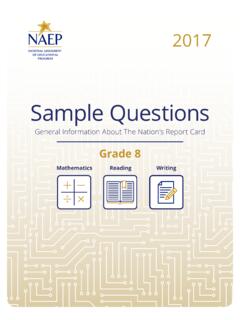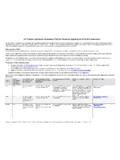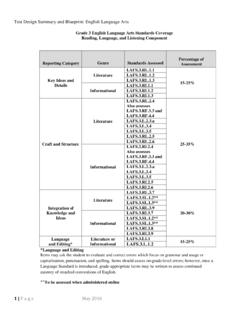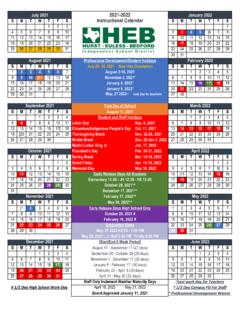Transcription of College Enrollment Rates - National Center for Education ...
1 The Condition of Education 2020 | 1 Chapter: 2/Postsecondary EducationSection: Postsecondary StudentsCollege Enrollment RatesThe overall College Enrollment rate for 18- to 24-year-olds increased from 35 percent in 2000 to 41 percent in 2018. In 2018, the College Enrollment rate was higher for 18- to 24-year-olds who were Asian (59 percent) than for 18- to 24-year-olds who were White (42 percent), Black (37 percent), and Hispanic (36 percent).The overall College Enrollment rate has increased since 2000. Different factors, such as changes in the labor market and the economy, may have contributed to this ,2 In this indicator, College Enrollment rate is defined as the percentage of 18- to 24-year-olds enrolled as undergraduate or graduate students in 2- or 4-year institutions. The Immediate College Enrollment Rate indicator, in contrast, presents data on the percentage of high school completers who enroll in 2- or 4-year institutions in the fall immediately following high school.
2 Figure 1. College Enrollment Rates of 18- to 24-year-olds, by level of institution: 2000 through 2018200020052010201520180102030405060708 090100 Total4-year2-yearPercentYearNOTE: Data are based on sample surveys of the civilian noninstitutionalized population. SOURCE: Department of Commerce, Census Bureau, Current Population Survey (CPS), October Supplement, 2000 through 2018. See Digest of Education Statistics 2019, table overall College Enrollment rate increased from 2000 to 2010. Similarly, the College Enrollment rate increased at both 2-year institutions and 4-year institutions during this period. Over a more recent time period, the overall College Enrollment rate in 2018 was not measurably different from the rate in 2010, but the rate at 2-year institutions decreased from 2010 (13 percent) to 2018 (10 percent), and the rate at 4-year institutions increased from 28 percent to 31 percent during this Condition of Education 2020 | 2 Chapter: 2/Postsecondary EducationSection: Postsecondary StudentsCollege Enrollment RatesFigure 2.
3 College Enrollment Rates of 18- to 24-year-olds, by race/ethnicity: 2000, 2010, and 2018 TotalWhiteBlackHispanicAsianPacific IslanderAmericanIndian/AlaskaNativeTwo or moreraces01020304050607080901003541 413943423138372232365664593624!164124384 4 Percent Race/ethnicity201020002018 Not available. ! Interpret data with caution. The coefficient of variation (CV) for this estimate is between 30 and 50 percent. NOTE: Data are based on sample surveys of the civilian noninstitutionalized population. Separate data for 18- to 24-year-olds who were Pacific Islander and of Two or more races were not available in 2000. In 2000, respondents of Two or more races were required to select a single race category. Prior to 2003, data for Asian 18- to 24-year-olds include Pacific Islander 18- to 24-year-olds. Race categories exclude persons of Hispanic ethnicity. Although rounded numbers are displayed, the figures are based on unrounded data.
4 SOURCE: Department of Commerce, Census Bureau, Current Population Survey (CPS), October Supplement, 2000, 2010, and 2018. See Digest of Education Statistics 2019, table 2000 to 2018, College Enrollment Rates among 18- to 24-year-olds increased for those who were Black (from 31 to 37 percent) and Hispanic (from 22 to 36 percent). The College Enrollment rate in 2018 was also higher than in 2000 for those who were White (42 vs. 39 percent). The College Enrollment rate was not measurably different between 2000 and 2018 for those who were Asian3 and American Indian/Alaska Native. More recently, the College Enrollment rate was higher in 2018 than in 2010 for those who were Hispanic (36 vs. 32 percent) and lower in 2018 than in 2010 for those who were American Indian/Alaska Native (24 vs. 41 percent). There was no measurable difference between the 2010 and 2018 College Enrollment Rates for those who were White, Black, Asian, Pacific Islander, and of Two or more races.
5 In 2018, the College Enrollment rate among 18- to 24-year-olds was higher for those who were Asian (59 percent) than for those of other reported racial and ethnic groups. In every year between 2000 and 2018, the College Enrollment rate for those who were Asian was higher than the Rates for those who were White, Black, and Hispanic, and the rate for those who were White was higher than the rate for those who were Black. The College Enrollment rate for those who were White was also higher than the rate for those who were Hispanic in every year between 2000 and 2018, except 2016, when the Rates were not measurably different. The Condition of Education 2020 | 3 Chapter: 2/Postsecondary EducationSection: Postsecondary StudentsCollege Enrollment RatesFigure 3. College Enrollment Rates of 18- to 24-year-olds, by sex and race/ethnicity: 2000 and 2018 PercentTotal1 WhiteBlackHispanicTotal1 WhiteBlackHispanic0102030405060708090100 33383639253318323844414535412540 Sex and race/ethnicityFemaleMale201820001 Includes other racial/ethnic groups not shown separately.
6 NOTE: Data are based on sample surveys of the civilian noninstitutionalized population. In 2000, respondents of Two or more races were required to select a single race category. Race categories exclude persons of Hispanic ethnicity. Although rounded numbers are displayed, the figures are based on unrounded data. SOURCE: Department of Commerce, Census Bureau, Current Population Survey (CPS), October Supplement, 2000 and 2018. See Digest of Education Statistics 2019, table Between 2000 and 2018, overall College Enrollment Rates increased for both 18- to 24-year-old males (from 33 to 38 percent) and females (from 38 to 44 percent). Among males, College Enrollment Rates were higher in 2018 than in 2000 for those who were White (39 vs.)
7 36 percent), Black (33 vs. 25 percent), and Hispanic (32 vs. 18 percent). Among females, College Enrollment Rates were also higher in 2018 than in 2000 for those who were White (45 vs. 41 percent) and Hispanic (40 vs. 25 percent). The rate in 2018 was not measurably different from the rate in 2000 for females who were every year since 2000, the College Enrollment rate for 18- to 24-year-olds overall was higher for females than for males. This pattern was also observed for both White and Hispanic 18- to 24-year-olds. For example, in 2018 the female-male gap in College Enrollment Rates was 7 percentage points for this age group overall, 6 percentage points for those who were White, and 9 percentage points for those who were Hispanic. Among those who were Black, the College Enrollment rate was higher for females than for males in most years since 2000, except in 2007, 2012, 2015, and 2016, when the Rates were not measurably different.
8 In 2018, the female-male gap in College Enrollment Rates for those who were Black was 8 percentage :1 Fry, R. (2009). College Enrollment Hits All-Time High, Fueled by Community College Surge. Washington, DC: Pew Research Center . Retrieved May 3, 2017, from 2 Brown, , and Hoxby, (Eds.). (2014). How the Financial Crisis and Great Recession Affected Higher Education . Chicago: University of Chicago Separate data for 18- to 24-year-olds who were Pacific Islander or of Two or more races were not available in 2000. Prior to 2003, data for Asian 18- to 24-year-olds included Pacific Islander 18- to 24-year-olds. Information from Digest of Education Statistics 2018, table , based on the Census Bureau Current Population Reports, indicates that 97 percent of all Asian/Pacific Islander 18- to 24-year-olds in 2018 were tables: Digest of Education Statistics 2019, table ; Digest of Education Statistics 2018, table indicators and resources: College Participation Rates [Status and Trends in the Education of Racial and Ethnic Groups]; Immediate College Enrollment Rate; Snapshot: College Participation Rates for Racial/Ethnic Subgroups [Status and Trends in the Education of Racial and Ethnic Groups]; Undergraduate Enrollment ; Young Adult Educational and Employment Outcomes by Family Socioeconomic Status [The Condition of Education 2019 Spotlight]Glossary: College ; Enrollment ; Gap; Racial/ethnic grou
